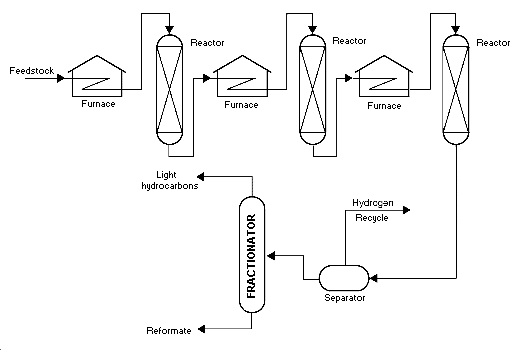Catalytic reforming is an important process used to convert low-octane naphthas into high-octane gasoline blending components called reformates. Reforming represents the total effect of numerous reactions such as cracking, polymerization, dehydrogenation, and isomerization taking place simultaneously. Depending on the properties of the naphtha feedstock (as measured by the paraffin, olefin, naphthene, and aromatic content) and catalysts used, reformates can be produced with very high concentrations of toluene, benzene, xylene, and other aromatics useful in gasoline blending and petrochemical processing. Hydrogen, a significant by-product, is separated from the reformate for recycling and use in other processes.
A catalytic reformer comprises a reactor section and a product-recovery section. More or less standard is a feed preparation section in which, by combination of hydrotreatment and distillation, the feedstock is prepared to specification. Most processes use platinum as the active catalyst. Sometimes platinum is combined with a second catalyst (bimetallic catalyst) such as rhenium or another noble metal.
There are many different commercial catalytic reforming processes including platforming, powerforming, ultraforming, and Thermofor catalytic reforming. In the platforming process, the first step is preparation of the naphtha feed to remove impurities from the naphtha and reduce catalyst degradation. The naphtha feedstock is then mixed with hydrogen, vaporized, and passed through a series of alternating furnace and fixed-bed reactors containing a platinum catalyst. The effluent from the last reactor is cooled and sent to a separator to permit removal of the hydrogen-rich gas stream from the top of the separator for recycling. The liquid product from the bottom of the separator is sent to a fractionator called a stabilizer (butanizer). It makes a bottom product called reformate; butanes and lighter go overhead and are sent to the saturated gas plant.
Some catalytic reformers operate at low pressure (50-200 psi), and others operate at high pressures (up to 1,000 psi). Some catalytic reforming systems continuously regenerate the catalyst in other systems. One reactor at a time is taken off-stream for catalyst regeneration, and some facilities regenerate all of the reactors during turnarounds.
